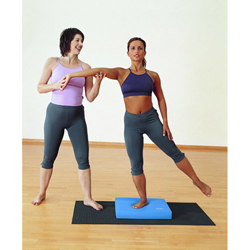The Bar and its Activating Functional Mobility book provide a host of effective exercises for physical therapy patients
When I first picked up an ActivMotion Bar®, I was instantly intrigued. So many ideas came into my head, I spent a few hours testing it out and I was instantly hooked. I brought it to work the next day and started integrating the Bar into the exercise programs of many of my patients – those dealing with balance issues, those with trouble correcting scapular dyskinesia, post-ACL reconstruction patients learning to use full knee extension and maintain their stability in standing, and patients learning to stabilize their entire bodies by connecting their scapula, trunk, and pelvis with dynamic movements.
Incredible Sensory Feedback
I use a wide variety of techniques and tools to facilitate and correct functional movement patterns, and I was surprised how the Bar not only fit into each patient’s exercise program but how much better it was than other tools. ActivMotion Bars provide the feedback that our patients need to be aware of and self-correct dysfunctional movement patterns. As we all know, self-awareness plus quality feedback provide the best environment for learning. The sensory feedback provided by the Bar is almost more accurate than we as PTs can be with our own eyes and movement assessment skills. It is more sensitive and more tactile, as a slight hike of the shoulder or a dip of the hip into Trendelenburg can cause the rolling steel weights to shift and let the user know that they’ve lost their stable position. In addition, it gives them feedback when they’re doing the exercise correctly, as they can feel the weights become stable, but not static, inside the Bar. I enjoyed seeing my patients respond quicker, become more motivated, and enjoy their exercise programs more when using the Bar. I soon saw many of my patients carrying the Bar around the clinic and asking to use it even for exercises that had not previously involved the Bar.
Creating a Comprehensive Program
When I was approached by ActivMotion and OPTP to come up with a manual for how to apply the Bar to the field of outpatient physical therapy, I felt challenged in creating something that would accurately represent the Bar and all of its capabilities. How do I build a systematic functional exercise program for something that is so dynamic? We collaborated, and eventually came up with a system of three different ways to use the Bar; the first two using the Bar for facilitation and the third using the Bar for eccentric resistance. I brainstormed daily in the clinic and compiled a list of exercises, then categorized them in to the three cardinal planes of motion (sagittal, frontal, and transverse) to provide a comprehensive program of corrective functional movements. The result is Activating Functional Mobility: A Guide to Rehabilitation Training with the ActivMotion Bar.

The exercises are divided into sections that each address a common area of instability: Scapular instability, trunk instability, and hip/pelvic instability. Having to hold and stabilize the Bar actually makes every exercise a scapular stability exercise. We commonly refer to the “core” as simply trunk and lower body stability, but it is important to include the scapula as it is the proximal attachment of the upper extremities to the trunk. As there is no inherent joint space or ligamentous stability in the scapulothoracic joint – only muscle attachments – nearly all stability here relies on muscular control. Within each section (scapular, trunk, and hip/pelvic) there are 9 different exercises: three levels of exercises in each of the cardinal planes of motion. From here we can start our patients with a beginner level exercise in any of the planes of motion and progress them from using the Bar to provide tactile feedback to assist with stabilization, to using the Bar for dynamic resistance and eccentric loading of the joint stabilizers.
Beginning Level Exercises: Introducing Balance & Proprioception
The beauty of the ActivMotion Bar lies in its versatility. The beginner level of exercises in each section of stability involves using the Bar pressed against the body to physically create a closed-chain connection between the body and the Bar. The tactile feedback of the Bar’s connection to the body as well as the tactile and auditory sensations of the rolling steel weights shifting as the patient strives to find equilibrium help to stimulate the patient’s proprioceptive systems and facilitate a correction of that movement through increased self-awareness. The beginner level of exercises involve keeping the Bar parallel to the floor and are more isolated movements focused on gaining static stability through tactile sensation. A hook-lying bridge while pressing the Bar into the hips is an example of a beginner level sagittal plane exercise. Using the Bar to anchor the upper extremities to the trunk and facilitating symmetry in the hips and pelvis is great for correcting common deviations of lumbar extension, asymmetrical hip extension, and muscle imbalances between sides.


Intermediate Level Exercises: Increasing the Core Stability Challenge
The intermediate level of exercises in each section of stability involves moving the Bar with the body, while also maintaining a parallel position of the Bar to create balance. Exercises in this section require more stability than the beginner section as the patient now has to work to control their body and the Bar together in more active, dynamic movement patterns. The intermediate level progression of the hook-lying bridge is the side plank hip swing, in which the patient maintains a stable forearm side plank with the Bar balanced on the top leg and flexes and extends the top hip. Maintaining a balanced position of the body while moving the top leg and Bar together dynamically improves hip and pelvic stability in individuals with gait deviations. The patient can hear and feel the weights in the Bar shifting if they don’t maintain neutral hip abduction, and they are simultaneously working on trunk and scapular stability to keep their balance.


Advanced Level Exercises: Dynamic Moves, Full Range of Motion
The advanced level of exercises in each section of stability involves tipping, tilting, or swinging the ActivMotion Bar to create dynamic resistance throughout the full range of motion and provide eccentric core muscle activation at the end ranges of the movement pattern. Patients can feel and hear the active resistance shift within the Bar, and use this as feedback to create a rhythm and sequence the movement correctly. As patients tip, tilt, and swing the Bar, the resistance shifts to the end of the Bar and creates an eccentric force resulting in even greater contraction of the major core muscles as they work to control the increased weight. In Activating Functional Mobility, the advanced level sagittal plane hip/pelvic stability exercise is the static lunge with overhead sidebend. The sagittal plane muscles are working to maintain a stable position of the lower extremities, while the trunk and scapular muscles activate dynamically to tip and tilt the Bar and create a sense of dynamic instability for the lower extremities. This exercise could also be considered an advanced frontal plane stability exercise for the trunk and scapular stabilizers.


An Excellent Method of Corrective Exercise
In nearly every exercise performed with the ActivMotion Bar, users are truly required to stabilize their entire body, making the Bar a very effective and efficient tool for facilitating functional movement patterns in corrective exercise. Capturing the benefit of these traits, Activating Functional Mobility contains an overview on the science behind facilitating stability and proprioception in the human body. It also contains information regarding the unique aspects of the ActivMotion Bar, and instruction on cueing fundamentals to assist you in helping your patients use the Bar to its fullest potential.







